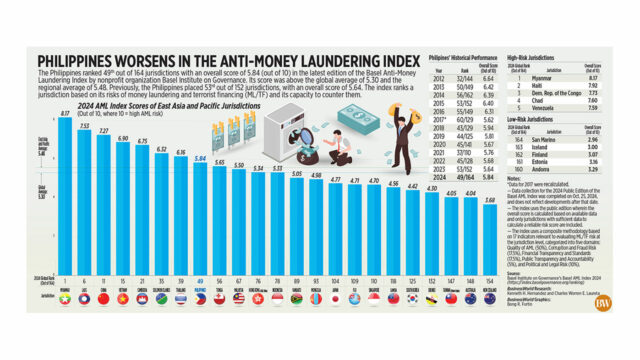(In this week’s column RJ Ledesma dives deep into business networking with Dr. Ivan Misner, the founder of the largest networking organization in the world, BNI.)
Ask any entrepreneur and they will tell you that networking is essential to any business. Success or failure in business all too often depends on who you know. It can make the difference in finding the right supplier, partnering with the right investor, or getting positive referrals about your product. It is instrumental in spreading word about your brand and growing your revenues. Simply put, networking can make or break your business.
I’m a strong believer in the power of networking. That’s why I’m a part of BNI Elite, one of the local chapters based out of Taguig. It’s also one of the many reasons why I’m so active in entrepreneurial education with this column, my podcast, the business website I lead, and even my hosting. The connections I form with networking have, time and again, proven to be so valuable in so many ways.
And I’m also a part of BNI Meet. That’s why it gives me great pleasure to share a conversation I had recently with Dr. Ivan Misner, the founder and Chief Visionary Officer of the largest networking organization in the world, BNI.
BNI has over 11,000 chapters with 310,000 members in 75 countries. Together, these members generated $24.3 billion in referrals — known in BNI as “thank you for closed business” referrals. To give you some scale of how big that number is, it’s larger than the GDP of 100 countries in the world.
But what exactly does BNI do? In Ivan’s own words, “BNI is a platform to create referrals for life… And so whatever business you’re in, it’s a way to generate a referral-based business.”
Now “referrals for life” is a big, bold statement, and I’ll talk more about that later. But first let’s talk a little more about networking.
Business networking is often misunderstood. Done right, it isn’t about constantly being a salesperson to every person you meet. Ivan simplifies it with an elegant statement. He says, “In BNI, it’s all about getting to know, like, and trust people. When you do that, you’re going to refer people.”
NETWORKING AND FILIPINO ENTREPRENEURS
Ivan’s visit to the Philippines couldn’t have come at a better time. With our country being one of today’s bright spots of the global economy, there is so much opportunity for our entrepreneurs and businesspeople.
Ivan is full of optimism for the Philippines, and he has a lot of positive things to say about Filipinos. “They’re sponges for knowledge and information,” he says. “And that is really healthy. And there are countries that we do business in that I think are very complacent… [Filipinos] are fully engaged, really on fire, very excited. And that’s fun to see. It’s exciting to see the development of entrepreneurism in a developing nation.”
NETWORKING LESSONS
So how does networking — in particular, the kind of networking practiced by BNI — work? Let’s take a closer look at a few of the lessons Ivan shared:
1. Join different networking groups. Just like making investments, with networking you also need to diversify.
Ivan says, “Don’t join four chambers [of commerce] or two groups like BNI. Be in a chamber of commerce, be in a service club like Rotary, be in a strong contact network like BNI. Then you’ve diversified the kinds of connections and the purposes of those, because each one has a slightly different purpose.”
2. Stick to the program. “Don’t reinvent the wheel,” Ivan advises. “The BNI program is really effective. It works in 75 countries. I would say the Philippines gets it right now. But as it grows, it’s very easy for entrepreneurs to start chasing bright, shiny objects. And the big challenge will be to get people to say, you know, stay on the path. The path works.”
3. Find your keys to growth. This particular message resonated with me. As an entrepreneur, I am often guilty of getting distracted by shiny things — new innovations, trends, and technology. Ivan reminds us that we don’t need to overcomplicate things. Instead, we should focus on our keys to growth and repeat these behaviors.
Ivan says, “You want to be successful in business? Do six things 1,000 times. Not 1,000 things, six times. And most business people do 1,000 things six times, and they can’t figure out why they’re not scaling their business.”
GIVER’S GAIN
Perhaps the most important piece of business wisdom that Ivan shared with me is something that he started our conversation with: the idea of “referrals for life,” which is intertwined with his philosophy of giver’s gain.
To understand this, we need to go back to the very beginning of BNI, 40 years ago.
As a young 28-year-old management consultant, Ivan’s business relied on speaking engagements and referrals. And to increase his referrals he joined networking groups but was quickly frustrated by what was available. They were either too hard sell or they hardly did any business at all, focusing on socializing instead. He decided to put up his own networking group.
“What I wanted was a group that did business, but wasn’t mercenary,” Ivan said, a group that was relational but not totally social. “And the glue that would hold it together is our philosophy of giver’s gain. This idea that if I help you, if I give you business, we’ll build a relationship. You’ll give me business.”
This philosophy of giver’s gain is based on the law of reciprocity, which basically states that if you help someone, others are more likely to help you. It is a simple idea with deep implications for business and networking — and for life.
Ivan says, “If you want to get business, you have to be willing to give business. You have to help other people.
“And giver’s gain is more than a phrase to me. It’s a way of living one’s life. And if it’s applied properly, it’ll change your life.
“And if it changes enough lives, it’ll change the world. And that’s what we’re doing.”
(If you would like to learn more about BNI, let me know. Send me an e-mail at ledesma.rj@gmail.com.)
RJ Ledesma (www.rjledesma.com) is a Hall of Fame Awardee for Best Male Host at the Aliw Awards, a multi-awarded serial entrepreneur, motivational speaker and business mentor, podcaster, an Honorary Consul and editor-in-chief of The Business Manual. Connect with Mr. Ledesma on LinkedIn, Facebook and Instagram. The RJ Ledesma Podcast is available on Facebook, Spotify, Google and Apple Podcasts.












